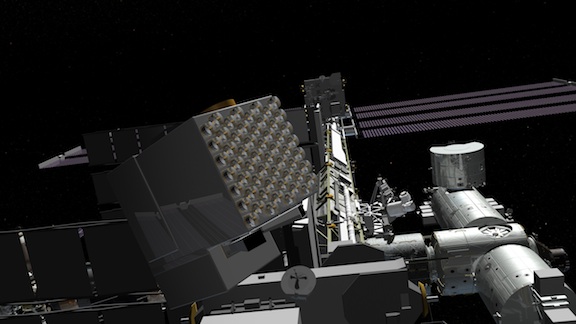
NASA’s Astrophysics Explorer Program has selected two missions to be launched in 2017. The Transiting Exoplanet Survey Satellite (TESS) will undertake an all-sky survey for planets, ranging from Earth-size to gas-giant, in orbit around the nearest and brightest stars in our sky, and the Neutron Star Interior Composition Explorer (NICER) will measure the variability of cosmic X-ray sources to study the interior and surface composition of neutron stars. Both TESS and NICER were among four concept studies submitted last September, and NASA has since determined that they represent the best scientific value and the most feasible development plans.
Scheduled for launch aboard a Pegasus-XL air-launched booster, the baselined two-year TESS mission is led by Massachusetts Institute of Technology in Cambridge, Mass., with seed funding from Google. Its principal investigator is George Ricker at MIT. The spacecraft will perform an extensive all-sky survey to detect “exoplanets”—planets beyond our solar system—as they transit the disks of their parent stars. Program-capped at $200 million, the TESS spacecraft bus will be equipped will four wide-angle telescope and charge-coupled device (CCD) detectors, with a total size of 192 megapixels. Data will be stored aboard TESS for three months, allowing ground-based investigators to sift its results for unexpected phenomena, such as gamma-ray bursts.

Of particular interest to the TESS team are “G” (yellow)- and “K” (orange)-class stars, with apparent magnitudes brighter than 12. Our Sun is a G-class main-sequence star, and other examples in the two classes include Alpha Centauri A and B and 51 Pegasi. The mission would examine around 2 million of these star types, including the 1,000 closest red dwarfs, and hopes are high that TESS will find at least 1,000, and perhaps as many as 10,000, transiting exoplanet candidates of the size of our world or larger and with orbital periods of up to two months. These candidates would then be observed with the High Accuracy Radial Velocity Planet Searcher (HARPS) at La Silla Observatory in Chile and by NASA’s forthcoming James Webb Space Telescope.
Meanwhile, NICER will be installed on one of the International Space Station’s Express Logistics Carriers and will spend 12-18 months studying neutron stars. The principal investigator for the mission is Keith Gendreau of NASA’s Goddard Space Flight Center in Greenbelt, Md. NICER has been described as “a fundamental investigation of extremes in gravity, material density and electromagnetic fields” and will measure the variability of cosmic X-ray sources (in a process known as X-ray “timing”) to explore the exotic states of matter within neutron stars.
Frequently described as the zombies of the cosmos, neutron stars are born when massive stars expend their supply of hydrogen and helium and collapse under their own gravity, crushing matter in their cores and expelling their outer layers in a supernova. The matter in the core is compressed by gravity to unimaginable densities—one teaspoon-full of the stuff would weigh a billion tons or more on Earth—and lives on as a city-sized neutron star. Its ability to packing remarkable concentrations of matter into a very small volume has placed it “right at the threshold of matter as it can exist,” according to NICER Deputy Principal Investigator Zaven Arzoumanian of NASA-Goddard. “If it gets any denser,” he added, “it becomes a black hole.”

Present efforts to simulate the interiors of neutron stars remain in their infancy. Particle accelerators can replicate some of the conditions, but only for a fraction of a second, leaving the key question of what happens to matter under such enormous pressures a mystery. NICER’s array of 56 telescopes will collect X-rays generated both from hotspots on a neutron star’s surface and from its powerful magnetic field and is expected, for the first time, to yield the first exact clues about their size. “The problem is that neutron stars are small, and much too far away to allow their sizes to be measured directly,” explained Keith Gendreau. “However, NICER will be the first mission that has enough sensitivity and time-resolution to figure out a neutron star’s size indirectly. The key is to precisely measure how much the brightness of the X-rays changes as the neutron star rotates.”
The Explorer Program is NASA’s longest-running continuous effort to provide frequent, low-cost access to space with principal investigator-led space science investigations in astrophysics and heliophysics. Since the launch of the first U.S. satellite, Explorer-1, in January 1958, more than 90 missions have flown, including the Cosmic Background Explorer (COBE), whose results contributed toward a Nobel Prize for Physics.
“The Explorer Program has a long and stellar history of deploying truly innovative missions to study some of the most exciting questions in space science,” said former astronaut John Grunsfeld, now NASA’s associate administrator for science in Washington, D.C. “With these missions, we will learn about the most extreme states of matter by studying neutron stars and we will identify many nearby star systems with rocky planets in the habitable zone for further study.”




I dont like the idea of NASA capturing a asteroid to prctice to eventualy to land on the Asteroid Vista by 2121. I like EM 1 mission to the dark side of the Moon and Rendavous and docking with inter stella distances, Astronuots need prctice for inter stella travel.